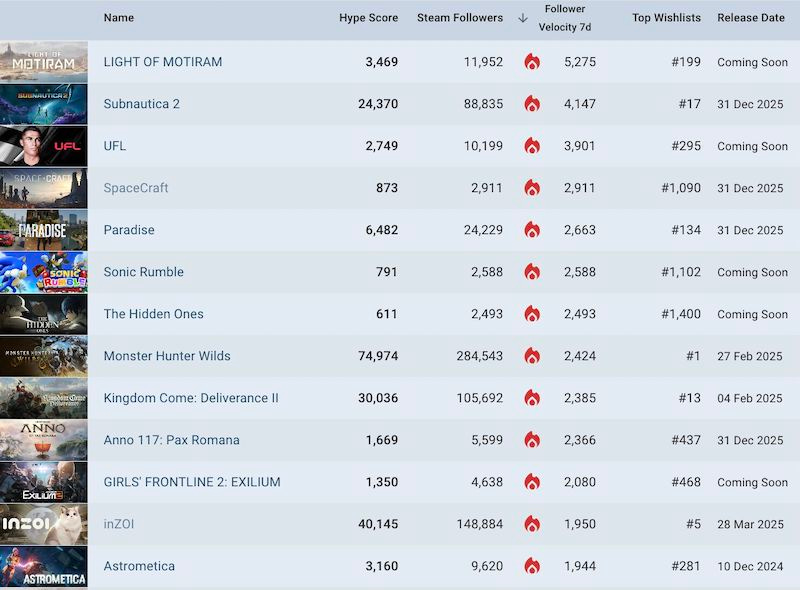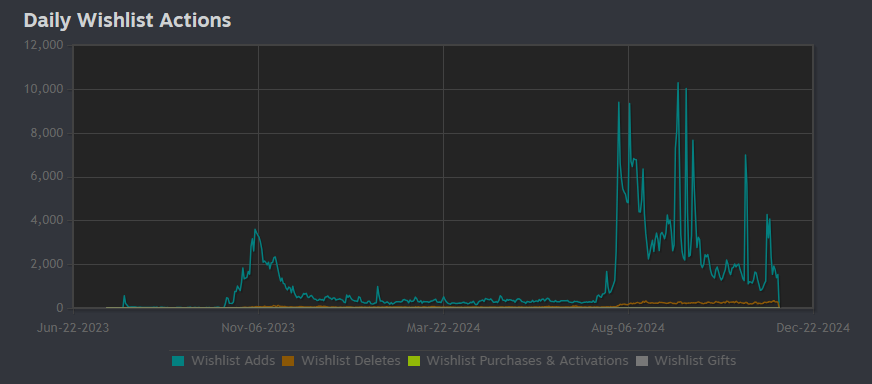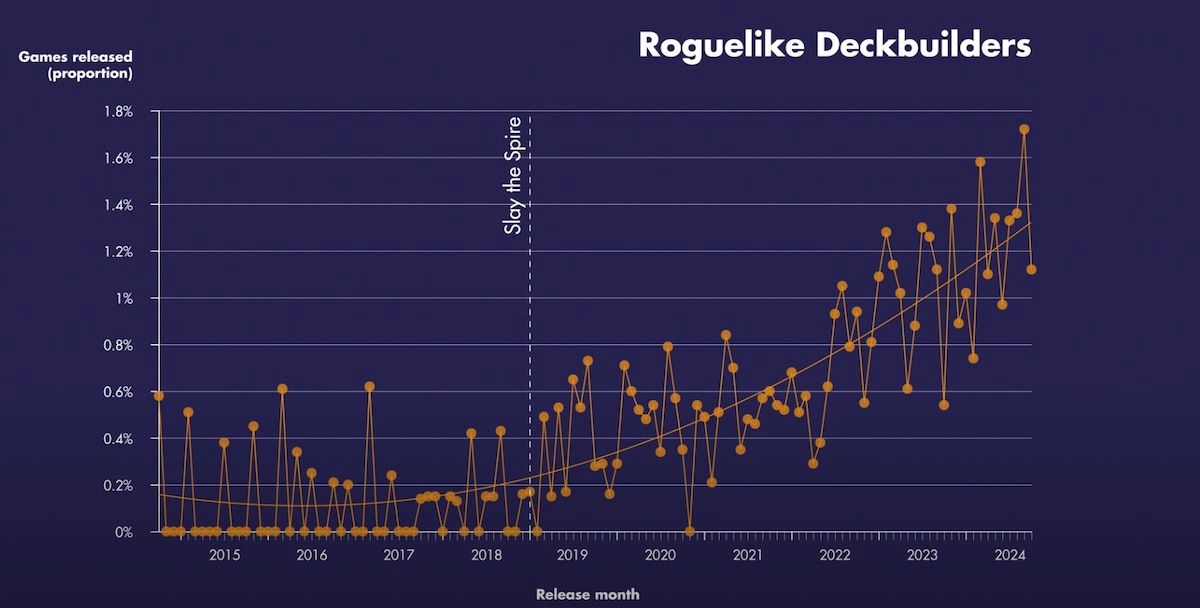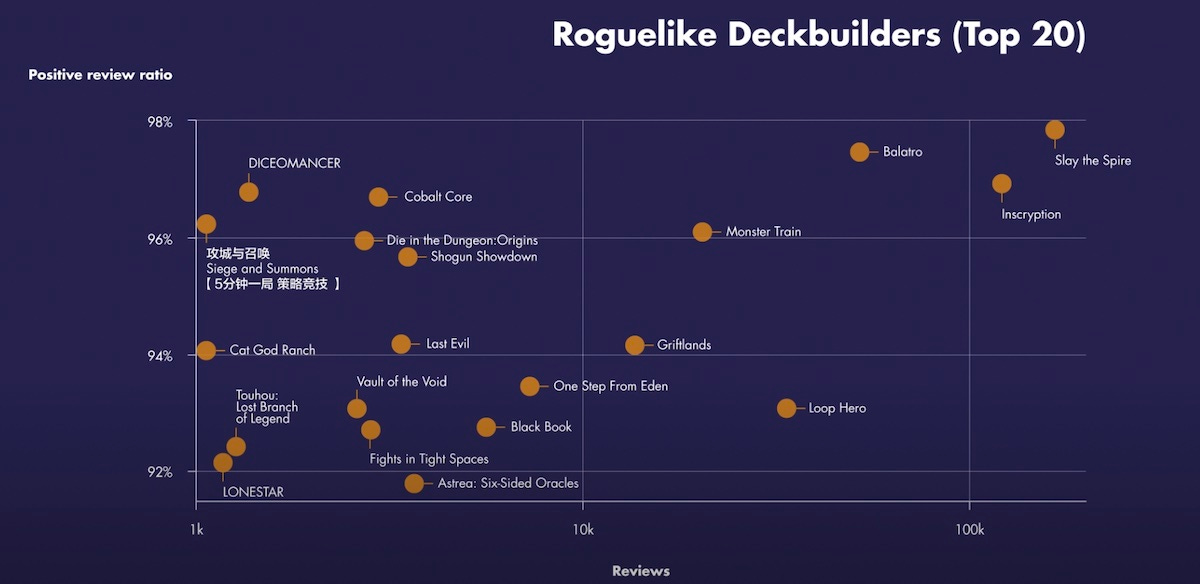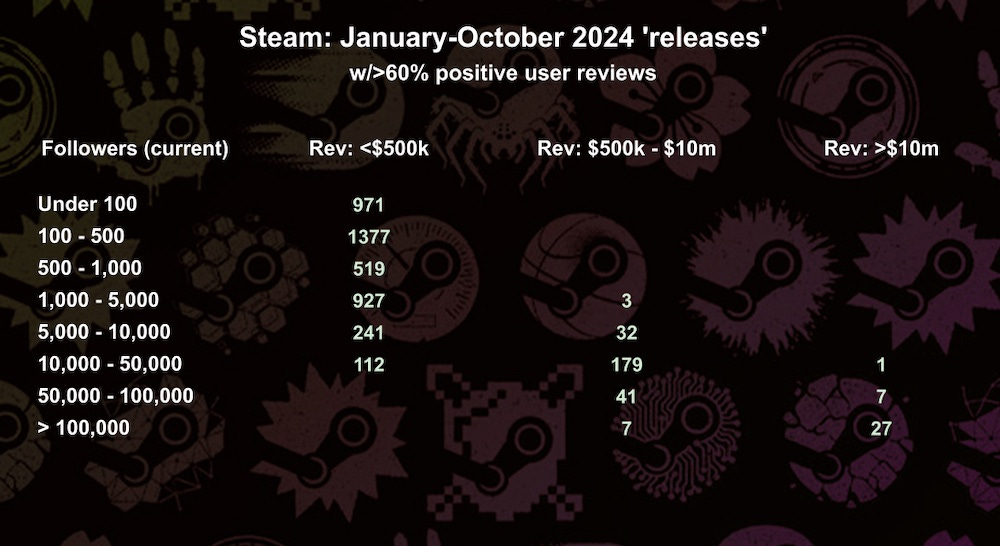How Half Sword slashed its way to ~600k Steam wishlists!
Publikováno: 11.12.2024
Also: why wishlists are still indicative, some neat Steam trend graphs, and more.
[The GameDiscoverCo game discovery newsletter is written by ‘how people find your game’ expert & company founder Simon Carless, and is a regular look at how people discover and buy video games in the 2020s.]
As we all limp through the end of the year - and the final GDCo newsletter of 2024, featuring charts galore, will likely be next Tuesday, Dec. 17th - we’re starting out the week with a giant newsletter on a multitude of delightful subjects.
Before we start, we highly recommend Julia Alexander’s essay ‘Taylor Swift is Not Going to Kick Off a Self-Publish Storm’, which references both music and BookTok to discuss power laws & the fact that: “When attention fragments, and the value of attention alone diminishes… the value of building intentions grows.” That’s our kinda sh*t.
[HEADS UP: as always, please support GameDiscoverCo by subscribing to GDCo Plus right now. You get basic access to our ‘core’ Steam data back-end, full access to our second weekly newsletter, our lively - and entertaining - Discord, eight game discovery eBooks & lots more.]
Game discovery news: Light Of Motiram interests..
Let’s start out with a bunch of game platform and discovery news, shall we? Here’s what we have in the hopper this time:
GDCo’s latest list of ‘trending’ unreleased Steam games - by follower additions in the last 7 days - has Horizon Zero Dawn-y survival crafter Light Of Motiram ascending to #1, with F2P soccer game UFL charting at #3, despite the fact it’s only out on PlayStation and Xbox, with the PC release date just being 'later'.
Elsewhere, new entries include Shiro's space exploration & building game SpaceCraft (#4), F2P party game Sonic Rumble (#6), and Asian martial arts action game The Hidden Ones (#7). The rather Subnautica-inspired Astrometica (#13) - now actually released - is handily beaten out by the actual Subnautica 2 (#2).
We just ran across Chris Hewish’s ‘video game confidence survey’, surveying key biz folks on how it’s all going - and in Nov. 2024, “17% of respondents believe the economic conditions in the video game industry have improved over the past year”, with 44% reporting worsening conditions. (Marginally up MoM, but not great.)
Lots of ‘Fortnite as platform’ announcements: the game “goes first-person for new 5v5 mode Ballistic”, Lego Fortnite gets a GTA-esque Brick Life game on the platform on Dec. 12th, and Epic is introducing new, creator-optional text chat in all Fortnite islands who want it.
Ahead of The Game Awards this Thursday in LA, did you know Game Conference Guide has a calendar for online showcases, complete with URLs to view the streams, which we apparently inspired GCG’s Pavol to set up! (We did? We did!)
Apple’s Vision Pro “could gain support for Sony PSVR 2 controllers soon, according to Bloomberg’s Mark Gurman.” Per The Verge: “Apple and Sony apparently planned to announce support for the controllers ‘weeks ago’… under this rumored partnership, Apple would begin selling Sony’s controllers, which aren’t currently available on their own.”
Via the GDCo Plus Discord: there’s apparently a new SteamWorks back-end note that - in the future, not now - Valve will (optionally?) email Steam followers of that game, dev or publisher, when devs publish Steam news posts. (Cool if true!)
PlayStation’s most-downloaded games for Nov. 2024 include “spooky newcomer Phasmophobia [rising] from the dead, landing in the top five of the US and EU charts. Metro Awakening claimed the top spot on November’s PS VR2 list in the US and EU.” And Call Of Duty: Black Ops 6 was #1 in almost all the major charts, of course…
There’s a new Consumer Technology Association survey which reveals that 65% of Americans aged 13+ have played a video game in the last 3 months. Also: “Most gamers (57%) enter the market between ages five and 12, while gaming activity peaks in high school (ages 15 to 17) and significantly declines after college (age 22-plus).”
Ichiro Lambe has updated his ‘19 years of Steam games’ activity chart, now that we’re close to seeing 100,000 games on Steam. You too can watch that line fly upwards and re-remember why PC game discovery is getting kinda tricky…
PlayStation nostalgia time: Shawn Layden chatted about why “it was a fight to get the Sony name” on the original PlayStation, because “a lot of leadership at the time didn’t take it seriously”; Famitsu asked Japanese gamers for their favorite PlayStation games of all time - headed by Final Fantasy VII, Xenogears & more.
Microlinks: this Meta Quest ‘most popular games’ page is interesting & maybe you didn’t know it existed; the Steam version of Indiana Jones allows you to cross-save your Steam, Windows Store and Xbox versions of the save game; Quest Black Friday 2024 sales volume on Amazon may have fallen short of 2023.
Half Sword: how it gored up 600k Steam wishlists
Sometimes, GameDiscoverCo gets more kudos for analyzing big games before they come out, rather than just saying ‘oh, this game was huge - why?’ So now’s a perfect time to look closely at physics-based medieval combat sim Half Sword, which is now at almost 600k Steam wishlists, with 401k since its Steam playtest launch in July 2024!
To give you context, it’s currently #53 in Steam’s ‘top wishlists’ chart for unreleased games, with most of that gain happening in the past 6 months. Check out this very pleasant Steam back-end wishlist graph for more context:
How? We chatted to the game’s creators Franchesko Togonidze & Ivan Nestorov, alongside Game Seer’s Bertrand Vernizeau, who is funding & publishing the title, and here’s what we found:
Pushing an ‘open’ playtest and demo has surged interest: Bertrand noted that the game’s free demo on Steam is at 1.7m downloads, a simultaneous Steam Playtest at 840k downloads, and Half Sword also has a version on Itch.io with 369k downloads.
The game’s physics-based melee combat is incredibly streamer-friendly:“the game and its extremely chaotic and gory physics elements” using Unreal Engine 5 “allows influencers to 'get on stage' and actually create their own experience.” The result? Roleplaying, faux betting, and the addition of blood is increasing virality.
Adding new weapons to the mix changes up gameplay: co-dev Ivan Nestorov told us: “once we introduce a new weapon, it can change the overall… tactics you need to take in order to be victorious.” The team started with swords, then added maces, an axe, and then longer weapons like poleaxes and spears. Each changed strategy!
As for overall interest, the Steam wishlists for Half Sword are quite, but not wholly Western: 36% North America, 20% Western Europe, 11% Asia, 8.5% Eastern Europe, 8% Central Asia, 5.5% Latin America, and 4% the Middle East. (Oh, and the game’s Discord is getting 250-1,000 new joiners every day, which ain’t bad!)
Anyhow, the result of all of this is, as Bertrand notes: “influencers on YouTube, Twitch, and TikTok have uploaded over 10,000 videos across 3,000 channels and… generated over 100m+ views since July.” In other words, video creators love the game, even when their videos are showcasing basic boxing x ‘smack talk’.
But what’s really going on here? We submit, humbly, that this is the re-emergence of a subgenre - the ‘serious*’ physics-based combat game. (*but goofy!) We’ve seen games like Gang Beasts and Party Animals thrive with a cartoony ‘real physics’ approach. But AA and AAA games have not tried this much, for both tech and animation reasons.
Yet guess what? If you’re not afraid of your characters looking a bit silly while you do some really clever physics-led simulation programming, there’s a whole world of crazy emergent gameplay to be had here. And that’s what streamers are responding to.
Anyhow, we talked to OG dev Franchesko Togonidze - for which Half Sword was his “student project when I studied in gamedev school in Japan and I worked on it in my free time while living in a shoebox.” And here’s why we think this idea is working:
There’s a rich understanding of inspirations in this subgenre: Franchesko notes that he “loved The Elder Scrolls games since middle school”, but combat never quite worked for him. And then both Kingdom Come Deliverance and cult isometric hit Exanima - “the OG and probably still the best physics based combat game I ever played” convinced him that there was a great game to be made here.
Beyond sandbox goofiness, there’s intent to make a ‘real’ sim: fine, a lot of influencers just want to cut heads off. But with Franchesko’s love of HEMA (Historical European Martial Arts), and Ivan’s history work - the game is focused around “German speaking lands in the year 1475” - there’s real historical heft.
It is very ‘not easy’ to make a physics-only human combat system: Franchesko says “physics are unpredictable… seeing the physics-driven character walking and balancing the first time was like witnessing a miracle.” And then getting multiple weapons and bodies to interact right is even harder, especially if characters need switch grips, change hands, etc.
So yes, Half Sword looks silly at times. But the emergent gameplay created from having real physics systems and limb/body simulation - as well as the very ‘open’ approach to making early versions free - is skyrocketing interest.
There’s a tinge of ?!? for me - personally - now the ‘blood’ patch has rolled out. (Is it too realistic?) But we’ve been told games don’t make you murderers. And we do know that the team is serious about the historical sim aspects, rather than this just being a big ol’ Maim-O-Dome! So we do have to say - we think this game is going to sell. A lot.
Visualizing the rise of roguelike deckbuilders…
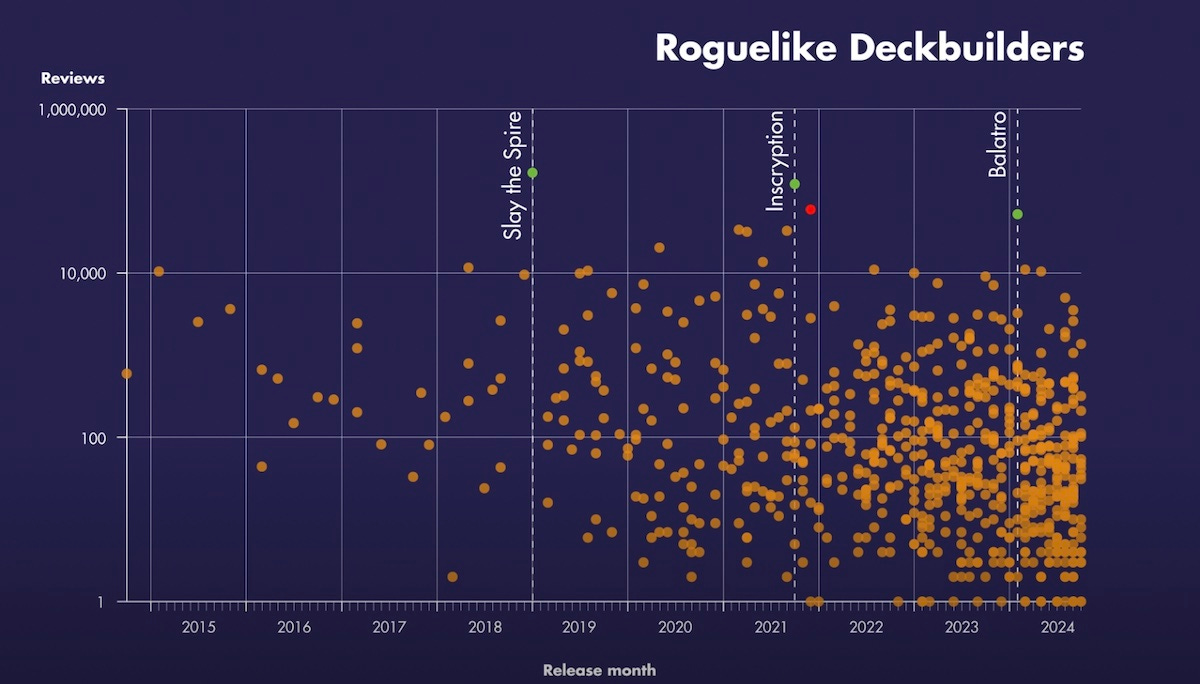
Next: we’re suckers for a good visualization here at GameDiscoverCo. So when we saw this new YouTube video, ‘I Scraped the Entire Steam Catalog, Here’s the Data’, we immediately clicked through and scanned it for juicy data points.
The video analyzes a bunch of word visualizations, best/worst reviewed games, and rare tag combos. But the best part for us was a look at the ‘roguelike deckbuilder’ genre - including all games by review total (above), with Slay The Spire - actually Early Access-ed in Nov. 2017, 1.0 release in 2019 - the start of a big genre boom.
One question you might immediately have is - sure, the release schedule has got way busier for this genre in recent years. But is the rise of the roguelike deckbuilder genre greater than the overall increase in games? Well, according to his data, yep, it is:
Fair enough! But wait, we’ve got an extra ‘gotcha’ for you. The roguelike deckbuilder tag was only added to Steam in June 2020, so could that have led to more games being tagged with it after that date? (While some were clearly retroactively tagged with it!)
But we still believe the gist of the data. And we also liked the below visualization, which was looking at the very top roguelike deckbuilders from the perspective of ‘>90% positive reviews, but also reviewed by a bunch of people!’ This is another great visualization - we’re tempted to try to adopt some of these for our SaaS platform:
Finally: a sanity check on Steam ‘wishlist peddling’
Of course, last week’s big newsletter on Steam wishlist conversions got quite a lot of response. And just detailing some of those, both data and trend-wise:
We found a couple of glitches in our data, and corrected around 10 items: thanks to those reporting! That raised the median ‘wishlist to 7 day sales conversion’ for Aug-Oct 2024 from 10.5% to… 10.8%. (So, not a whole bunch.)
We got some anecdotal evidence we might be conservative on the low end: a couple of folks suggested that their conversions for games that sold single-digit thousands were a bit better than we estimated. If so, great - we’ll keep tweaking.
There was more controversy over how much wishlists ‘matter’: one big meta question that keeps being raised is - should we even believe ‘the wishlist cult’ at all, with such divergent results?
Well, thanks to Steve Stopps of Excalibur (whose newly announced Long Drive North is getting a lot of, uhh, wishlists right now), we have some good backup to our contention that wishlists are not reliable sales calculators, but they are ‘indicative’.
Steve looked at all games released on Steam from January to October 2024 with at least 60% positive Steam reviews, grouped everything based on current Steam followers and overall lifetime revenue, and got the following chart:
The data isn’t perfect - there’s probably some former Early Access games in there, current followers might not map to pre-release ones precisely. But again, it’s generally showing that Steam followers and followers/wishlists are ‘indicative’.
Which is to say: games with less Steam followers and wishlists do indeed perform less well than games with more of them. And sure, quoting William Goldman about the movies: “Nobody knows anything.” But you can’t build a strategy in the absence of any data. So we’ll take imperfect data over 100% gut instinct, every time…
[We’re GameDiscoverCo, an agency based around one simple issue: how do players find, buy and enjoy your PC or console game? We run the newsletter you’re reading, and provide consulting services for publishers, funds, and other smart game industry folks.]
